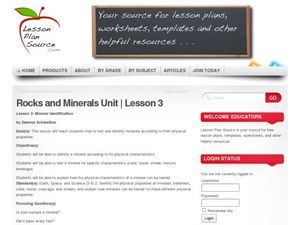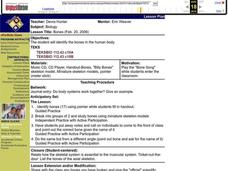Curated OER
Rocks and Minerals Unit
Students test and identify minerals according to their physical properties. In this mineral analysis instructional activity, students brainstorm ways to identify rocks and list their ideas on chart paper. Students study samples in pairs...
Curated OER
Anatomy of the Heart
Tenth graders examine the different parts of the heart. In this biology lesson, 10th graders perform dissection of the fetal pig. They explain how the heart maintains homeostasis.
Curated OER
Water, Glorious Water
Students identify the various uses of water. In this water conservation lesson, students read the book, The Drop In My Drink: The Story of Water On Our Planet and write down their favorite uses of water. Students illustrate how they can...
Curated OER
African American Inventors Study
Middle schoolers learn about African American inventors. In this inventing lesson, students are assigned an African American inventor to research. Middle schoolers work in pairs to complete their research. Students write a compare and...
Curated OER
Baleen Whales vs. Toothed Whales
Second graders review mammal characteristics and study two types of whales. In this mammal study lesson, 2nd graders discuss mammals and define their five characteristics. Students complete a whale worksheet and define differences...
Curated OER
Friendly Flowers
Students listen to music while creating flowers with a partner. They decide on a philanthropic act related to flowers. They recognize the difference between private property and common resources. They use a problem-solving model to...
Curated OER
Who Will Benefit if We Give Bulbs What They Need to Grow?
Young scholars identify the elements needed for bulbs to grow. They raise tulips and give them to various members of the community. They identify local philanthropic communities and look for ways they can constructively donate time and...
Curated OER
IDENTIFYING AND SORTING BEARS
Students study the difference between living and nonliving bears by classifying pictures of bears and placing them on the appropriate posterboard. Given pictures of bears, students recognize types of bears by placing the pictures correctly.
Curated OER
WHAT DO BEARS EAT AND HOW DO THEY WALK?
Students listen to the poem "Five Bears" read aloud several times, and study what bears eat by naming the foods (mentioned in the poem) out loud. They draw a picture to illustrate one line of the poem and practice choral reading.
Curated OER
Autumn
Students observe the different patterns of leaves and record their observations after reading the book "Autumn Leaves".
Curated OER
Buoyant Force
Students investigate the scientific concept of why some objects float when put in a liquid solution. They apply the laws of motion and force while conducting classroom activities. Students also take notes and answer target questions to...
Curated OER
Recycling: Causes of Pollution
Students read The Lorax by Dr. Seuss while focusing on similarities in their world and that of the Lorax by completing a worksheet. They examine the effects of pollution or garbage on the environment.
Curated OER
Waves, Sound, and Light
Ninth graders explain waves in terms of energy transfer and describe their basic types and characteristics. They solve mathematical problems involving wavelength and frequency. Students conduct experiments in reflection and refraction.
Curated OER
Effects of the Southern Pacific Railroad Causeway
Fifth graders describe the appearance of a substance before and after a physical change. They re-create the Southern Pacific Railroad Causeway across the Great Salt Lake. They determine for themselves how the water is exchanged...
Curated OER
Energy in Living Systems
Students are asked: Is our life's purpose over when it's over? What happens to our bodies? They analyze the flow of energy through living systems. Students compare the metabolism of autotrophs with that of heterotrophs. They create a...
Curated OER
Monocots vs. Dicots
Students examine the differences in nonvascular and vascular plants. They compare the differences between gymnosperm and angiosperms. Students compare the differences between moocots and dicots. They view a powerpoint presentation on...
Curated OER
Bones
Students listen to the song "Bone Song" as they enter the class. They identify the bones in the human body. Students are given the topic: Do body systems work together? Give an example. They work in groups of two and study the bones...
Curated OER
The Heart
High schoolers explore the structures in the heart and follow the path of blood through the heart and lung. They copy the Fill-in-the blank notes from the colored folders that are located at the stations throught the room. Students are...
Curated OER
Review of the Scientific Method
Students review the Scientific Method with a hands-on activity. Working with a partner, they hypothesize the number of water drops that fit on the heads side of a penny. They collect data and share their results with the remainder of...
Curated OER
9 Phyla of the Animalia Kingdom.
Young scholars identify characteristics of all 9 phyla of the Animalia Kingdom. They create a table of the 9 phyla and research a representative organism for each.
Curated OER
Meiosis, Gene Linkage and Maps
Young scholars identify the structures that actually assort independently. They are taught how gene maps are produced. Students compare the processes of mitosis and meiosis. They are shown their (mitosis and meiosis) significane to...
Curated OER
Diversity of Protists
Students identify under a microscope several different genera of protists. They discuss the three different categories of protists. Students discuss characteristics of the protists that they have already been taught. They view and...
Curated OER
Natural Selection
Young scholars comprehend that natural selectionis the tool for adaptation and evolution of populations. They pick three M&M's and no candy corns. Students tally the number of different color M&M's chosen. They discuss why...
Curated OER
Geologic Time Scale
Students recreate and comprehend the geologic time scale. They discuss how long humans have been around on Earth. Students are shown the geologic time scale and its different parts. They work in groups to recreate the time scale.























